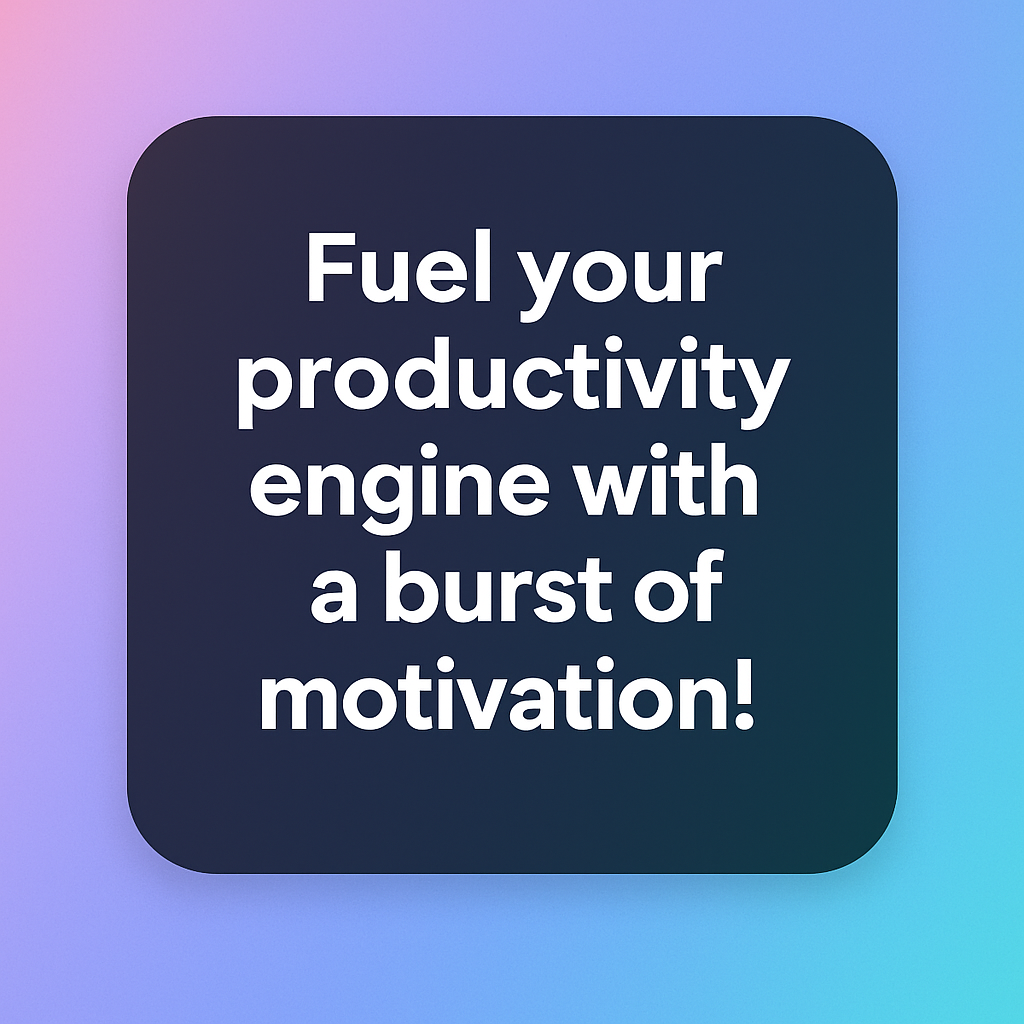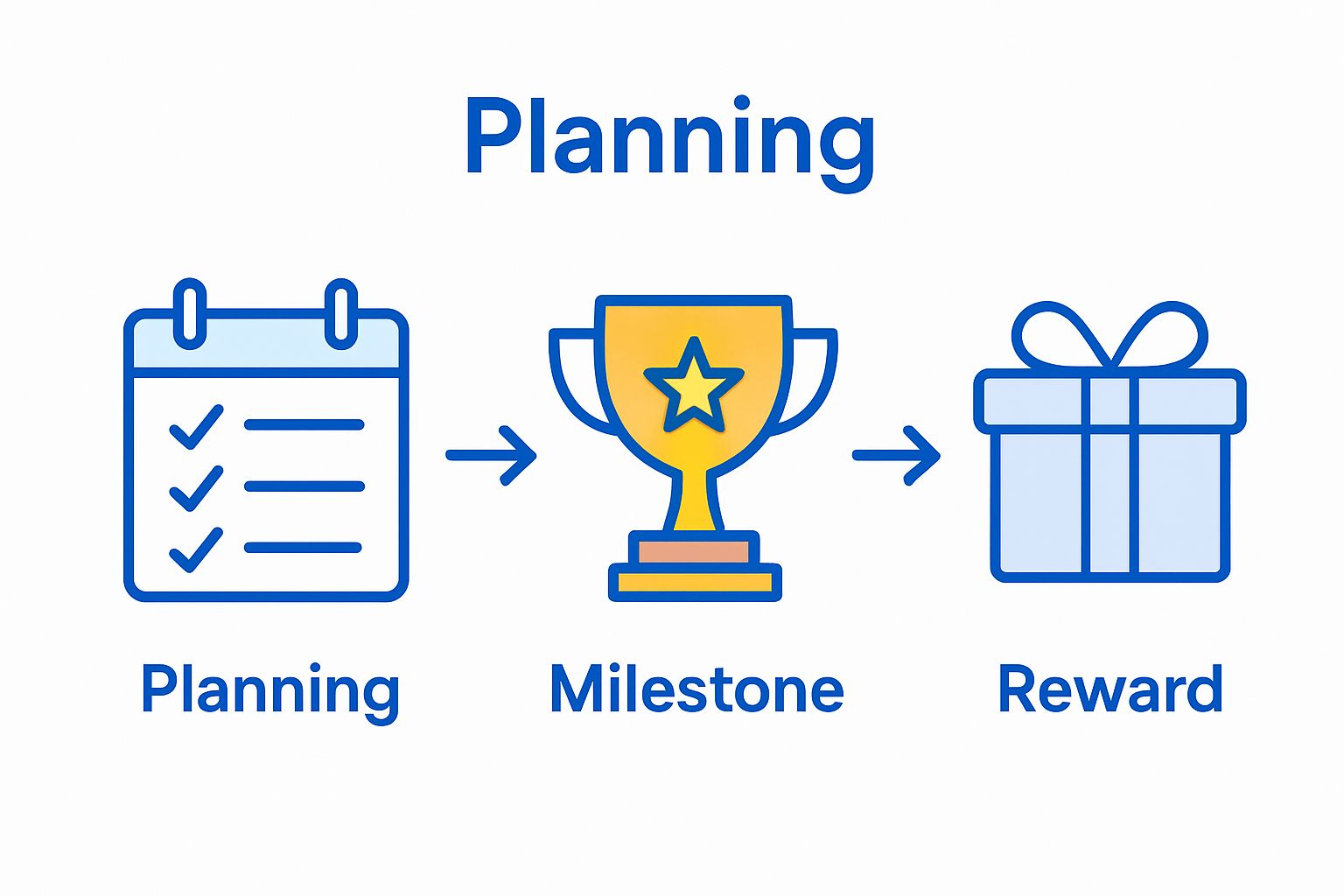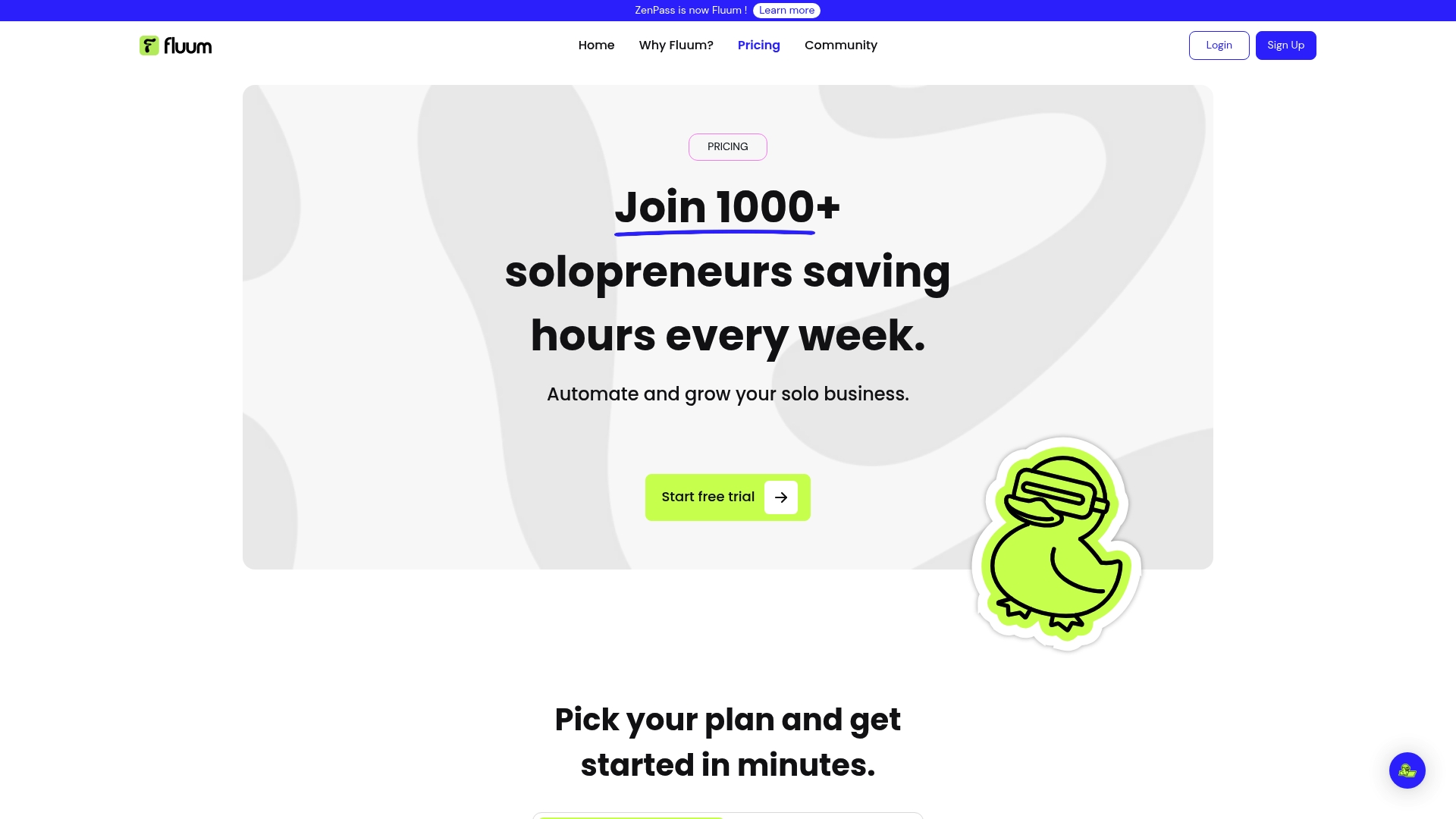
How to stay motivated is so important and clarity is the underrated engine behind long term motivation. Most people think staying driven is about sheer willpower or working longer hours. But studies show that those who set specific, measurable goals are dramatically more likely to succeed and stick with their plan. The real secret is not in pushing yourself harder but in making your goals sharp, structured, and personal.
Table of Contents
- Step 1: Define Your Personal Goals Clearly
- Step 2: Create a Daily Action Plan
- Step 3: Set Up a Reward System for Milestones
- Step 4: Establish a Support Network for Accountability
- Step 5: Monitor Your Progress Regularly
- Step 6: Adjust Your Strategies Based on Feedback
Quick Summary
| Key Point | Explanation |
|---|---|
| 1. Define Specific Goals | Clearly articulate specific, measurable objectives for enhanced motivation and actionable planning. |
| 2. Create Daily Action Plans | Develop a structured plan each day to convert your goals into consistent actions that push you forward. |
| 3. Implement a Reward System | Design a reward structure to celebrate milestones, boosting motivation through meaningful incentives. |
| 4. Build a Support Network | Establish connections with supportive peers for accountability, enhancing your commitment to professional growth. |
| 5. Regularly Monitor Progress | Assess your progress weekly to adapt strategies, ensuring you remain aligned with your goals and motivated. |
Step 1: Define Your Personal Goals Clearly
So, how to stay motivated? Motivation starts with clarity. When you understand precisely what you want to achieve, your brain creates powerful neural pathways that transform abstract desires into actionable plans. Personal goal setting is not just about writing down random aspirations but crafting a strategic roadmap that resonates with your deepest professional and personal motivations.
Begin by creating specific, measurable goals that reflect your true professional objectives. Instead of vague statements like “I want to be successful,” articulate concrete outcomes such as “I will increase my client base by 25% in the next six months” or “I will develop two new service packages that generate additional monthly revenue.” These precise goals provide immediate context and direction for your motivation.
The most effective goal-setting approach involves breaking down larger objectives into smaller, manageable milestones. Think of these as stepping stones that create momentum and build confidence. For instance, if your primary goal involves expanding your business, your initial milestones might include researching potential market niches, developing a targeted marketing strategy, and scheduling initial client consultations.
Psychological research supports this approach of incremental goal achievement. A study on motivation and goal setting demonstrates that individuals who create clear, structured goals are significantly more likely to maintain long-term motivation and successfully implement their plans.
Consider creating a visual representation of your goals. A goal map or vision board can transform abstract concepts into tangible imagery, making your objectives feel more real and achievable. This technique helps activate both emotional and rational parts of your brain, providing additional motivational fuel.
Finally, align your goals with your core values and long-term vision. Goals that genuinely reflect your personal and professional aspirations will naturally generate more intrinsic motivation. Learn more about setting strategic business goals to ensure your objectives are not just ambitious but also meaningful and sustainable.
Step 2: Create a Daily Action Plan
Transforming your goals into reality requires more than aspiration it demands a structured daily approach that converts intention into consistent action. A well-crafted daily action plan serves as your personal roadmap, guiding you through professional challenges and keeping you focused on your most critical objectives.
Start by understanding the power of intentional planning. Every successful professional knows that productivity is not about working harder but working strategically. Begin each evening by mapping out the next day’s critical tasks. This practice allows your subconscious mind to process and prepare for upcoming challenges while providing a clear sense of direction when you wake up.
Research on productivity confirms that individuals who develop structured daily plans are substantially more likely to achieve their long-term goals. Your action plan should prioritize tasks based on their strategic importance and potential impact, not just their urgency. Identify your most important tasks that directly contribute to your larger goals and schedule them during your peak energy hours.
Implement a time-blocking technique that allocates specific periods for different types of work. For instance, dedicate uninterrupted morning hours to deep, creative work that requires intense concentration. Reserve administrative tasks for periods when your mental energy naturally dips. This approach ensures you are matching your most demanding tasks with your highest performance windows.
Include buffer time in your daily plan to account for unexpected challenges or opportunities. Professional flexibility is key to maintaining motivation. Your action plan should not feel like a rigid constraint but a dynamic framework that allows for organic adjustments while keeping you aligned with your core objectives.
Consider using digital tools or explore daily mindset rituals that can help systematize your planning process. Simple techniques like color-coding tasks, using time-tracking apps, or maintaining a digital dashboard can transform abstract goals into tangible, trackable actions.
At the end of each day, conduct a brief review of your completed tasks. This reflection serves two critical purposes: celebrating your achievements and identifying areas for improvement in your next day’s planning. Consistent review creates a positive feedback loop that continuously refines your approach and sustains motivation.
Step 3: Set Up a Reward System for Milestones
Motivation is not just about discipline it is also about creating a positive psychological framework that celebrates progress and reinforces productive behaviors. A well-designed reward system transforms your professional journey from a potentially monotonous path into an engaging, fulfilling experience that continuously fuels your momentum.
Psychological research confirms that strategic reward systems can significantly enhance intrinsic motivation. Scientific studies demonstrate that anticipating and receiving rewards activates the brain’s pleasure centers, making goal achievement more compelling and enjoyable.
Design your reward system with intentionality and personal significance. The most effective rewards are not generic but deeply meaningful to you. Consider creating a tiered reward structure that matches the complexity and importance of each milestone. Small achievements might warrant simple pleasures like a favorite coffee or an hour of uninterrupted personal time, while significant professional breakthroughs could merit more substantial rewards such as a weekend getaway or investing in a professional development course.

Implement a tracking mechanism that provides visual representation of your progress. This could be a digital dashboard, a physical progress board, or a dedicated journal where you document milestones and corresponding rewards. The act of visually mapping your achievements creates additional motivation and provides a tangible sense of advancement.
Here is a summary table outlining common types of rewards you can implement and their suggested uses for achieving different milestone levels:
| Reward Type | Example Reward | Milestone Size | Purpose |
|---|---|---|---|
| Simple Pleasure | Favorite coffee or treat | Small | Immediate boost for minor achievements |
| Personal Time | Uninterrupted hour for hobbies | Small-Medium | Maintains balance and reduces burnout |
| Professional Development | Online course or new book | Medium | Skills advancement and sustained motivation |
| Experience | Weekend getaway or special outing | Large | Celebrate significant breakthroughs |
| Tool/Resource | Purchase new software or equipment | Medium-Large | Invests in further professional growth |
| Passion Project Time | Dedicated session for a side project | Medium | Increases intrinsic motivation |
| Recognition | Share achievement with network | Any | Amplifies success and accountability |
Ensure your rewards are proportional and aligned with your professional growth. Avoid rewards that contradict your broader objectives or create financial strain. The goal is to create a sustainable motivation ecosystem that supports your long-term success. A reward might be learning a new skill, attending a conference, purchasing a tool that enhances your professional capabilities, or dedicating time to a passion project.
Be mindful of potential reward fatigue. Rotate and diversify your rewards to prevent them from becoming predictable or losing their motivational impact. Experiment with different types of rewards that engage various aspects of your personal and professional satisfaction.
Finally, integrate reflection into your reward process. After receiving a reward, take time to consciously acknowledge the effort, skills, and perseverance that led to your achievement. This practice transforms rewards from simple transactional experiences into meaningful moments of personal recognition and growth.
Step 4: Establish a Support Network for Accountability
Motivation thrives in community. Professional isolation can quickly erode your drive and commitment, making a strategic support network an essential component of sustained personal and career growth. Accountability is not about external pressure but creating a collaborative environment that amplifies your potential and keeps you aligned with your professional objectives.
Intentional connection is the cornerstone of an effective support network. Seek out professionals who share similar aspirations but bring diverse perspectives and experiences. These connections should be carefully curated to include individuals who are not just supportive but also constructively challenging. Look for mentors, peers, and colleagues who demonstrate a genuine interest in your growth and are willing to provide honest, actionable feedback.
Research confirms that social support significantly enhances goal achievement and personal motivation. Your network should include a mix of relationships that serve different purposes. Some connections might offer technical expertise, while others provide emotional support during challenging periods.
Consider establishing structured accountability mechanisms. This could involve monthly progress meetings, quarterly goal review sessions, or weekly check in calls with trusted professional contacts. Technology makes these connections easier than ever. Virtual platforms, professional networking groups, and industry specific forums provide multiple avenues for building meaningful professional relationships.
Develop a reciprocal approach to accountability. Your support network should not be a one sided arrangement where you solely receive guidance. Offer your insights, expertise, and support to others. This mutual exchange creates a robust ecosystem of professional development that benefits all participants.
Be strategic about communication within your network. Set clear expectations about the type of support you seek. Some professionals prefer direct, solution oriented feedback, while others might appreciate a more empathetic approach. Communicate your preferences and be open to adapting your communication style based on individual network members.
Remember that building a support network is an ongoing process. Regularly evaluate the effectiveness of your connections. Some relationships will naturally evolve or fade, while new opportunities for collaboration will emerge. Stay open, proactive, and intentional about nurturing these professional relationships that contribute to your motivational journey.

Step 5: Monitor Your Progress Regularly
Progress monitoring is the compass that guides your motivational journey, transforming abstract goals into tangible achievements. Without consistent evaluation, even the most ambitious plans can drift off course, losing momentum and clarity. Regular progress tracking is not about creating additional pressure but developing a sophisticated understanding of your professional trajectory.
Strategic self-assessment requires more than superficial checklist completion. Scientific research demonstrates that individuals who systematically monitor their progress are significantly more likely to adjust strategies and achieve their objectives. Develop a comprehensive tracking system that captures both quantitative metrics and qualitative insights.
Implement a weekly review ritual that goes beyond simple task completion. During this dedicated time, analyze not just what you accomplished but how you accomplished it. Examine the strategies that worked effectively, identify potential bottlenecks, and reflect on the emotional and psychological factors that influenced your performance. This holistic approach transforms progress monitoring from a mechanical exercise into a powerful personal development tool.
To help you monitor progress effectively, the following table presents different methods and tools for tracking your goals, along with their strengths and best-use scenarios:
| Tracking Method | Example Tool | Strengths | Best For |
|---|---|---|---|
| Spreadsheet Log | Excel or Google Sheets | Customizable, quantifiable data | Tracking quantitative metrics |
| Project Management App | Asana, Trello, Monday | Visual boards, task management | Scheduling and monitoring tasks |
| Dedicated Journal | Physical or digital notebook | Qualitative insights, reflection | Emotional/psychological progress review |
| Goal Tracking Software | Todoist, Goalscape, Strides | Automated reminders, analytics | Habit building and milestone alerts |
| Color-Coded Boards | Whiteboard, Kanban board | Quick visual summary | Multi-dimensional overviews |
| Rating System | 1-5 scoring in notebook or app | Fast self-assessment | Tracking satisfaction and energy levels |
Utilize digital tools and technologies that facilitate precise tracking. Spreadsheets, project management applications, and specialized goal tracking software can provide visual representations of your progress. These tools help translate abstract goals into concrete data points, making your achievements tangible and your challenges more manageable.
Be compassionate and objective during your progress reviews. Avoid harsh self criticism or unrealistic expectations. Instead, approach your assessment with curiosity and a growth mindset. Recognize that deviations from your original plan are not failures but opportunities for learning and refinement.
Consider developing a color coded or numerical rating system that allows you to quickly assess different dimensions of your progress. For instance, you might rate your goal achievement, energy levels, strategy effectiveness, and personal satisfaction on a scale of 1 to 5. This multifaceted approach provides a nuanced view of your professional development.
Remember that progress monitoring is a dynamic, evolving process. Your tracking methods should be flexible enough to adapt as your goals and professional landscape change. Regularly reassess your monitoring approach, ensuring it remains relevant, motivating, and aligned with your broader professional objectives.
Step 6: Adjust Your Strategies Based on Feedback
Feedback is the critical fuel that transforms potential into performance. Professional growth is not about rigidly adhering to an initial plan but about maintaining strategic flexibility and developing the wisdom to evolve your approach based on real world insights. The ability to adapt quickly distinguishes successful professionals from those who remain stuck in unproductive patterns.
Developing a dynamic feedback framework requires intentional and systematic approaches. Create multiple channels for receiving constructive input from various sources professional peers, clients, mentors, and your personal support network. Each perspective offers unique insights that can reveal blind spots in your current strategy. Be open to criticism not as a personal attack but as valuable information that can refine your professional trajectory.
Implement a structured method for collecting and analyzing feedback. This might involve quarterly review sessions with your accountability partners, anonymous client surveys, or periodic self assessments that challenge your existing assumptions. The goal is to create a comprehensive view of your performance that goes beyond surface level observations.
Research indicates that professionals who consistently integrate feedback into their strategy development are more likely to achieve sustainable growth. Consider developing a feedback matrix that categorizes input into actionable categories such as skill development, process improvement, and strategic realignment.
Be particularly attentive to patterns and recurring themes in the feedback you receive. Isolated comments might be subjective, but consistent observations across multiple sources often reveal genuine opportunities for improvement. This approach transforms feedback from a potential source of frustration into a powerful tool for strategic evolution.
Learn to distinguish between constructive feedback and noise. Not all input is equally valuable. Develop discernment in evaluating feedback by considering the source’s expertise, the specificity of their observations, and the potential impact of implementing suggested changes. Explore strategies for improving client experience to enhance your ability to interpret and act on professional feedback effectively.
Remember that strategy adjustment is an ongoing process. Approach each feedback cycle with curiosity and openness, recognizing that professional growth is less about perfection and more about continuous learning and adaptation.
Ready to Put Your Motivation Into Action?
Struggling to keep your energy high and your goals on track can leave even the most driven solopreneurs feeling overwhelmed. This article showed you how important it is to set clear goals, create daily plans, celebrate milestones, and build accountability. The truth is that staying motivated and productive is much easier when you do not have to juggle ten different tools or worry about missing details that hold your business back.

Imagine having an AI-powered co-founder by your side every single day. With Fluum, you can automate time-consuming admin, keep track of your progress using built-in templates, and never lose sight of your next milestone. Join a growing network of solopreneurs who use smart tools to turn intentions into results and celebrate every step forward. Explore real pricing options here and let your motivation fuel bigger business breakthroughs. Start today so your efforts finally add up to real growth.
Frequently Asked Questions
How can I define my personal goals to boost my motivation?
To boost your motivation, define specific, measurable goals that reflect your true professional objectives. For example, instead of saying, ‘I want to be successful,’ state, ‘I will increase my client base by 25% in six months.’
What steps can I take to create an effective daily action plan?
Start by mapping out your critical tasks each evening for the next day, prioritizing them by importance and scheduling them during your peak energy hours. Use techniques like time-blocking to enhance your productivity and focus.
How do I set up a reward system for achieving my milestones?
Design a reward system that includes meaningful rewards tied to your milestones. For instance, treat yourself to a favorite coffee for small achievements or plan a weekend getaway for larger breakthroughs.
What should I include in my support network for accountability?
Include professionals who share your aspirations and bring diverse perspectives to your support network. Cultivate relationships with mentors, peers, and trusted colleagues who can offer constructive feedback and encouragement.
How often should I monitor my progress toward my goals?
Monitor your progress weekly to analyze what you’ve accomplished and how you achieved it. Use this time to identify effective strategies and potential bottlenecks in your workflow to keep your motivation high.
How can I adjust my strategies based on feedback?
Regularly gather feedback from peers and mentors to inform your strategy adjustments. Create a system for processing this input, identifying patterns, and categorizing it into actionable steps for ongoing professional development.
Recommended
- Fluum | Effective Stress Management Techniques for Busy Professionals
- Fluum | How to Onboard Clients Effectively for Lasting Success
- Fluum | Master Managing Multiple Projects for Success
- Fluum | Build Your Brand with a Branding Builder in 2025
- Fluum | 7 Customer Retention Examples to Boost Your Business
- 7 Morning Routines For Productivity Every Entrepreneur Needs



